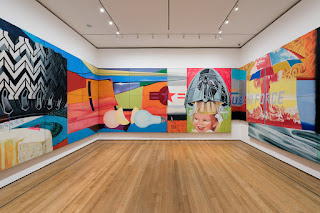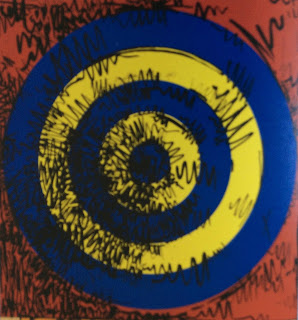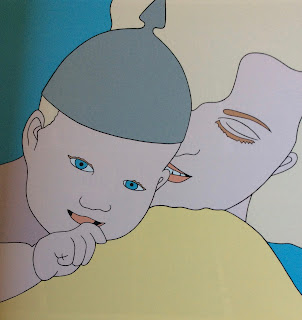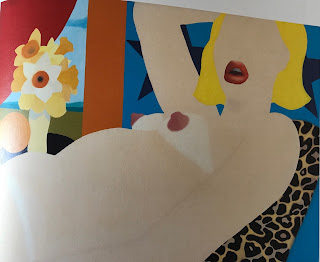ANOTHER LOOK AT POP ART...
After that rather bleak experience at the Maison Rouge, I needed to have something more colourful to look at. The next exhibition on my rather long list was « Pop Art - Icons that matter » - the Whitney Museum of American Art
Collection. I’m pretty sure that it was with Laurent and Jerome that I went to see the Roy Lichtenstein retrospective many years ago. What ever it was, Pop Art certainly didn't really stimulate my curiosity. So why would I go along to this event? Simple, to see why I didn’t really like it. All the major Icons were there. 60 + paintings. Fortunately the Maillol Museum can hang such large works successfully. They have space even if the crowd was in place when I got there. The exhibition focuses on figures such as Jasper John (the American flag that we all know too well), Robert Rauschenberg (for me his name always conjures up huge collage and I have never really liked them), Andy Warhol ( Marilyn Monroe and Cambell Tomato soup cans), Tom Wesselmann (huge paintings of rather voluptuous ladies), James Rosenquist (his bill boards were very familiar in the US. Huge once again) The list of artists was far longer than I expected. New ones that I did not know : Claes Oldenburg, George Segal (French) Rosalyn Drexler, John Wesley, Alan D’Arcangelo, James Dine, Robert Indiana, Allan Jones, Alex Katz, Richard Lindner, Christina Ramberg, Mel Ramos, May Steven, Harold Edgerton... I may work out why I’m not really tempted to follow Pop Art by the time I have done the tour?
It was at the beginning of he 1960’s that the USA witnessed a new generation of artists who were reacting to the Abstract Expressionism movement which I like so much. I guess all over the world, the economy was flourishing and the Pop Art movement emerged in this context. The artists generally focused on objects and symbols from the most popular culture frequently appropriating iconic images which made us all remember but not necessarily where they had come from or who had created them. Jacky Kennedy, Marilyn Monroe became icons of advertising. All of them were large and I guess one could say that it was a rather cynical portrait of the great « American Way of Life ».
Let’s have a look at some of the work I discovered.
James Dine. Along with 8 other artists, he was the first to exhibit in an exhibition called "New Painting of Common Objects", which helped to launch the Pop Art Movement. His work is rather strange. He used common everyday objects - mainly those belonging to him and attaches something on them …difficult to see perhaps, but this is called «Double isometric self portrait ». There is something hanging on the middle of the garment that looks like a cord which we would pull to turn a light on ...
Rosalyn Drexler was one of the first women to make a name for herself in Pop Art. Before that it was very much a « boys club »! There was an exhibition in 1965 « First International Girlie Show » where the major Pop artists were exhibiting alongside the girls. The few women artists who did make a small place in the movement never gained the recognition as their men counterparts. The little I saw of her work was the dramatisation of events or people. This for instance is called « Marilyn Pursued by Death "
Everyone has seen this work of Robert Indiana. « Love 1968 » His work LOVE, with its four letters stacked in a square somewhere in the USA and its O at a jaunty angle, is so famous that many millions of viewers may not even realise it’s an artwork at all. But it is. It has been used in so many forms, sculptures and even Christmas Cards but I’m pretty sure the not many know where their roots are. All his work related to something which was going on in the States in the 60s.
Jasper Johns is known for his American flags so it was nice to know that he had a palette which was rather larger than that...
Allen Jones - was English and taught both in the UK and the States. This may sum up his work

Alex Katz says that his work is uncomplicated. He did huge paintings of his wife and these collage sculptures are very realistic - self portraits…
Roy Lichentstein’s « Explosion » (1967) is impressive as is « Gold Fish Bowl » (1977). A move away from those huge ladies he seemed to paint so often. He created his first paintings of cartoon and comic strip icons with his trademark use of dots. By 1964, Lichtenstein was one of Pop artists recognised, yet controversial at the same time. Not being a cartoon fan, I can’t say that this work really impresses me but when he moves away from what most of us know, his work is quite interesting.
Richard Linder was born in Germany but his family came to the States quite early in his life. What I have seen of his work could be described as
 Claes Oldenburg - yet again another unknown name and it will go one for as long as I live, I have no doubt. An American artist best known for his public installations typically featuring large replicas of everyday objects. Another theme in his work is « soft sculpture versions » of everyday objects. Here is just one of them.
Claes Oldenburg - yet again another unknown name and it will go one for as long as I live, I have no doubt. An American artist best known for his public installations typically featuring large replicas of everyday objects. Another theme in his work is « soft sculpture versions » of everyday objects. Here is just one of them.
« Giant Fagends » (1967)
Christina Ramberg was one of the rare women in the movement who made a « small » name for herself. She is best known for her depictions of partial female bodies forced into submission by undergarments and imagined in odd, erotic predicaments. Here in a very restricted corset. She is surely not appealing to a male audience here but trying to get the woman out of bondage…well that’s how I see it.
Mel Ramos - American and is
well really!
Or how about this?
George Segal - the name I relate to is an American actor but obviously it couldn’t be him. So I found out that this Segal was very much a sculptor.
He was one of the pioneers for the use of plaster bandages. Those normally used for orthopaedic casts. He actually wrapped a model with the bandages then removed the hardened forms to put them back together with more plaster to form a hollow shell. In the early years he worked with only white casts and then later with colour. I found this a very melancholic sculpture….
Another woman - (at last) - May Stevens - American - and another activist. The Triple Daddy Blues » series. This series was allegedly showing her father and as she saw him - racist and dominating…However she did a lot of other painting and was awarded with quite a few prizes.
John Wesley -what caught my eye at once was this. Winny the Pooh (1965) He mixes images of traditional emblems, historical figures, comic book personalities, animals, sexy women, athletes and showgirls into surreal daydreams, prompting us to join his own private dream-world.. Look at all those Pooh that encircle the frame…and is Pooh protecting the naked lady?
I'll let you fantasise over this painting…but from what I saw, all Wesley’s work was symbolic.
And another on the left of John Wesley "Priscilla the Hun", 1971So different from the previous two.
Allan d'Arcangelo seemed to ring a bell when I saw this..
He was an American artist end printmaker , best known for his paintings of highways and road signs that border on pop art and miniamalism.His subject matter is distinctly American and evokes, at times, a cautious outlook on the future of this country. This is certainly symbolic as it really does look like Jaqui Kennedy and her daughter and is called "Madonna and Child" (1963)
I liked what I found on Harold "Doc" Edgerton, who was an inventor, entrepreneur, explorer and beloved MIT professor. His philosophy was
Above all, he was a scientist and photographer...This is quite weird..."30 Bullet Piercing an Apple" (1984-1990)
Tom Wessleman and Andy Warhol are not unknown to us - so here are just a few paintings from the two artists that perhaps show other aspects of their work.
I had come to the end. No photos to be taken so it wasn’t until I came home with a descriptive brochure of the exhibition that I could plunge a little deeper into this movement. I would simply describe Pop Art as monumental, statements for that period in the 60s when sex came into the open light, students revolted, women demanded their rights and everything seemed to be bigger and better - like The American Dream. Too big for me…
 |
| This is the Moma installation.. |
Collection. I’m pretty sure that it was with Laurent and Jerome that I went to see the Roy Lichtenstein retrospective many years ago. What ever it was, Pop Art certainly didn't really stimulate my curiosity. So why would I go along to this event? Simple, to see why I didn’t really like it. All the major Icons were there. 60 + paintings. Fortunately the Maillol Museum can hang such large works successfully. They have space even if the crowd was in place when I got there. The exhibition focuses on figures such as Jasper John (the American flag that we all know too well), Robert Rauschenberg (for me his name always conjures up huge collage and I have never really liked them), Andy Warhol ( Marilyn Monroe and Cambell Tomato soup cans), Tom Wesselmann (huge paintings of rather voluptuous ladies), James Rosenquist (his bill boards were very familiar in the US. Huge once again) The list of artists was far longer than I expected. New ones that I did not know : Claes Oldenburg, George Segal (French) Rosalyn Drexler, John Wesley, Alan D’Arcangelo, James Dine, Robert Indiana, Allan Jones, Alex Katz, Richard Lindner, Christina Ramberg, Mel Ramos, May Steven, Harold Edgerton... I may work out why I’m not really tempted to follow Pop Art by the time I have done the tour?
It was at the beginning of he 1960’s that the USA witnessed a new generation of artists who were reacting to the Abstract Expressionism movement which I like so much. I guess all over the world, the economy was flourishing and the Pop Art movement emerged in this context. The artists generally focused on objects and symbols from the most popular culture frequently appropriating iconic images which made us all remember but not necessarily where they had come from or who had created them. Jacky Kennedy, Marilyn Monroe became icons of advertising. All of them were large and I guess one could say that it was a rather cynical portrait of the great « American Way of Life ».
Let’s have a look at some of the work I discovered.
James Dine. Along with 8 other artists, he was the first to exhibit in an exhibition called "New Painting of Common Objects", which helped to launch the Pop Art Movement. His work is rather strange. He used common everyday objects - mainly those belonging to him and attaches something on them …difficult to see perhaps, but this is called «Double isometric self portrait ». There is something hanging on the middle of the garment that looks like a cord which we would pull to turn a light on ...
 |
| 1964 |
 |
| 1963 |
 |
 |
| R. Indiana "Mate" 1960-62 |
 |
| Target with Four Faces : 1958 |
 |
| Jasper Johns "Light Bulb" - 1956 |
Allen Jones - was English and taught both in the UK and the States. This may sum up his work
"I wanted to kick over the traces of what was considered acceptable in art. I wanted to find a new language for representation... to get away from the idea that figurative art was romantic, that it wasn't tough. This he describes as « young, witty, sexy, gimmicky, glamorous and Big Business »…
Pour Les Lèvres -1965
Take it or leave it!

Alex Katz says that his work is uncomplicated. He did huge paintings of his wife and these collage sculptures are very realistic - self portraits…
Roy Lichentstein’s « Explosion » (1967) is impressive as is « Gold Fish Bowl » (1977). A move away from those huge ladies he seemed to paint so often. He created his first paintings of cartoon and comic strip icons with his trademark use of dots. By 1964, Lichtenstein was one of Pop artists recognised, yet controversial at the same time. Not being a cartoon fan, I can’t say that this work really impresses me but when he moves away from what most of us know, his work is quite interesting.
 |
| Explosion - 1967 |
 |
| Gold Fish Bowl - 197 |
 |
| Ice - 1966 |
Richard Linder was born in Germany but his family came to the States quite early in his life. What I have seen of his work could be described as
« powerful images of robot like figures, amazons and heroines, harlequins of self-styled heroes »
I would think that this painting could be called erotic?
 Claes Oldenburg - yet again another unknown name and it will go one for as long as I live, I have no doubt. An American artist best known for his public installations typically featuring large replicas of everyday objects. Another theme in his work is « soft sculpture versions » of everyday objects. Here is just one of them.
Claes Oldenburg - yet again another unknown name and it will go one for as long as I live, I have no doubt. An American artist best known for his public installations typically featuring large replicas of everyday objects. Another theme in his work is « soft sculpture versions » of everyday objects. Here is just one of them. « Giant Fagends » (1967)
 |
| Istrean River Lady - 1974 |
Christina Ramberg was one of the rare women in the movement who made a « small » name for herself. She is best known for her depictions of partial female bodies forced into submission by undergarments and imagined in odd, erotic predicaments. Here in a very restricted corset. She is surely not appealing to a male audience here but trying to get the woman out of bondage…well that’s how I see it.
Mel Ramos - American and is
"best known for his paintings of superheroes and voluptuous female nudes emerging from cornstalks or Chiquita bananas, popping up from candy wrappers or lounging in martini glasses »
Tobacco Rhoda - 1965
well really!
Or how about this?
 |
| Eagle Beaver - 1969 |
 |
| The Bus Station » - 1965 |
George Segal - the name I relate to is an American actor but obviously it couldn’t be him. So I found out that this Segal was very much a sculptor.
He was one of the pioneers for the use of plaster bandages. Those normally used for orthopaedic casts. He actually wrapped a model with the bandages then removed the hardened forms to put them back together with more plaster to form a hollow shell. In the early years he worked with only white casts and then later with colour. I found this a very melancholic sculpture….
 |
| Triple Ddy Blues - 1968 |
Another woman - (at last) - May Stevens - American - and another activist. The Triple Daddy Blues » series. This series was allegedly showing her father and as she saw him - racist and dominating…However she did a lot of other painting and was awarded with quite a few prizes.
 |
| Pooh - 1965 |
John Wesley -what caught my eye at once was this. Winny the Pooh (1965) He mixes images of traditional emblems, historical figures, comic book personalities, animals, sexy women, athletes and showgirls into surreal daydreams, prompting us to join his own private dream-world.. Look at all those Pooh that encircle the frame…and is Pooh protecting the naked lady?
 |
| Ovum - 1971 |
I'll let you fantasise over this painting…but from what I saw, all Wesley’s work was symbolic.
 | |||||
And another on the left of John Wesley "Priscilla the Hun", 1971So different from the previous two.
 | |||||||
Allan d'Arcangelo seemed to ring a bell when I saw this..
He was an American artist end printmaker , best known for his paintings of highways and road signs that border on pop art and miniamalism.His subject matter is distinctly American and evokes, at times, a cautious outlook on the future of this country. This is certainly symbolic as it really does look like Jaqui Kennedy and her daughter and is called "Madonna and Child" (1963)
I liked what I found on Harold "Doc" Edgerton, who was an inventor, entrepreneur, explorer and beloved MIT professor. His philosophy was
"Work hard. Tell everyone everything you know. Close a deal with a handshake. Have fun!"
 |
| Great American Nude #57 |
 |
| Tom Wesselmann "Seascape n° 15" 1967 |
 |
| Andy Warhol - "Nine Jackies" -1964 |
 |
| Before and After 4. 1962 |
I had come to the end. No photos to be taken so it wasn’t until I came home with a descriptive brochure of the exhibition that I could plunge a little deeper into this movement. I would simply describe Pop Art as monumental, statements for that period in the 60s when sex came into the open light, students revolted, women demanded their rights and everything seemed to be bigger and better - like The American Dream. Too big for me…






Commentaires